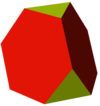Octahedron
If you are from 141 you know who this is its Abe yes its me ha i ruined u from answering the science homework lolz
Geometric relations
The interior of the compound of two dual tetrahedra is an octahedron, and this compound, called the stella octangula, is its first and only stellation. Correspondingly, a regular octahedron is the result of cutting off from a regular tetrahedron, four regular tetrahedra of half the linear size (i.e. rectifying the tetrahedron). The vertices of the octahedron lie at the midpoints of the edges of the tetrahedron, and in this sense it relates to the tetrahedron in the same way that the cuboctahedron and icosidodecahedron relate to the other Platonic solids. One can also divide the edges of an octahedron in the ratio of the golden mean to define the vertices of an icosahedron. This is done by first placing vectors along the octahedron's edges such that each face is bounded by a cycle, then similarly partitioning each edge into the golden mean along the direction of its vector. There are five octahedra that define any given icosahedron in this fashion, and together they define a regular compound.
Octahedra and tetrahedra can be alternated to form a vertex, edge, and face-uniform tessellation of space, called the octet truss by Buckminster Fuller. This is the only such tiling save the regular tessellation of cubes, and is one of the 28 convex uniform honeycombs. Another is a tessellation of octahedra and cuboctahedra.
The octahedron is unique among the Platonic solids in having an even number of faces meeting at each vertex. Consequently, it is the only member of that group to possess mirror planes that do not pass through any of the faces.
Using the standard nomenclature for Johnson solids, an octahedron would be called a square bipyramid.
Related polyhedra
Tetratetrahedron
The octahedron can also be considered a rectified tetrahedron - and can be called a tetratetrahedron. This can be shown by a 2-color face model. With this coloring, the octahedron has tetrahedral symmetry.
Compare this truncation sequence between a tetrahedron and its dual:
 Tetrahedron |
 Truncated tetrahedron |
 octahedron |
 Truncated tetrahedron |
 Tetrahedron |
Octahedra in the physical world

- Especially in roleplaying games, this solid is known as a d8, one of the more common Polyhedral dice.
- If each edge of an octahedron is replaced by a one ohm resistor, the resistance between opposite vertices is 1/2 ohms, and that between adjacent vertices 5/12 ohms.[1]
- The plates of kamacite alloy in octahedrite meteorites are arranged paralleling the eight faces of an octahedron
Octahedra in music
If you place notes on every vertex of an octahedron, you can get a six note just intonation scale with remarkable properties - it is highly symmetrical and has eight consonant triads and twelve consonant diads. See hexany
Other octahedra
The regular octahedron has 6 vertices and 12 edges, the minimum for an octahedron; nonregular octahedra may have as many as 12 vertices and 18 edges.[1]
- Hexagonal prism: 6 squares, 2 hexagons
- Heptagonal pyramid: 7 triangles, 1 heptagon
- Tetragonal bipyramid: 8 triangles, usually isosceles)
- The regular octahedron is a special case with equilateral triangles
- Truncated tetrahedron: 4 triangles, 4 hexagons
- Tetragonal trapezohedron - 8 kites
See also
- Spinning octahedron
- Stella octangula
- Triakis octahedron
- Hexakis octahedron
- Truncated octahedron
- Octahedral molecular geometry
References
- ^ Klein, Douglas J. (2002). "Resistance-Distance Sum Rules" (PDF). Croatica Chemica Acta. 75 (2): 633–649. Retrieved 2006-09-30.
External links
- Octahedron - Mathworld.com
- Paper model of the octahedron
- K.J.M. MacLean, A Geometric Analysis of the Five Platonic Solids and Other Semi-Regular Polyhedra
- The Uniform Polyhedra
- Virtual Reality Polyhedra The Encyclopedia of Polyhedra
- Paper Models of Polyhedra Many links
- Octahedron - Jewellery Software
